
Cleomedes is a prominent lunar impact crater located in the northeast part of the visible Moon, to the north of Mare Crisium. It was named after Greek astronomer Cleomedes. It is surrounded by rough ground with multiple crater impacts. The irregular crater Tralles intrudes into the northwest rim. To the east is Delmotte. North of Cleomedes is a triple-crater formation with Burckhardt occupying the center.
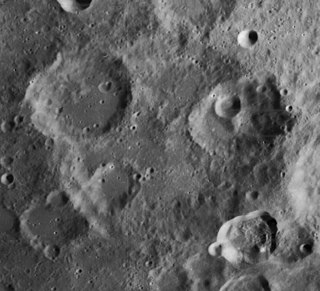
Hommel is a lunar impact crater located in the southeast section of the Moon, in a region that is deeply impacted with a multitude of impact craters. The most notable craters nearby are Pitiscus to the north; Rosenberger due east; and Nearch to the southeast. The prominent crater Vlacq is nearly attached to the northeast rim. Also nearby is Asclepi to the west. Hommel is about 120 kilometers in diameter and its walls reach heights of 2,800 meters. It is from the Pre-Nectarian period, 4.55 to 3.92 billion years ago.

Donati is a lunar impact crater that is located in the rugged south-central highlands of the Moon. It lies just to the northwest of the crater Faye, and the two outer rims are separated by a gap of less than 10 kilometers. To the north is the comparably sized Airy, and farther to the southeast is Playfair. Donati is 36 kilometers in diameter.

Calippus is a small lunar impact crater that is located on the eastern edge of the rugged Montes Caucasus mountain range in the northern part of the Moon. It was named after Greek astronomer Callippus of Cyzicus. It lies to the southwest of the crater remnant Alexander, to the northwest of the Mare Serenitatis.

Belʹkovich is a large lunar impact crater of the form termed a walled plain. The formation has been heavily eroded by a history of subsequent impacts, leaving it reshaped, worn, and the features softened and rounded. Belʹkovich is located along the northeastern limb of the Moon, and so its visibility is subject to libration effects. From the Earth this crater is viewed from the side, making it difficult to view it in detail.

Borda is a lunar impact crater that lies between Santbech to the north-northwest and Reichenbach slightly further away to the south-southeast. It was named after French astronomer Jean-Charles de Borda. It has a low rim that is broken along the southeast by a smaller crater. The rim is intruded into by another small crater along the southwest side, and there is an irregular cleft along the northwest face. There is a central peak at the midpoint of the floor.

Fabry is a large lunar impact crater of the form termed a walled plain. It is located on the far side of the Moon, just beyond the northeastern limb. Parts of this area are sometimes brought into view by the effects of libration, but the terrain is seen from the edge and so not much in the way of detail can be observed.

Curtius is a lunar impact crater that is located in the southern part of the Moon. From the Earth the crater appears foreshortened, making it more difficult to observe detail. Nevertheless, this is a large crater that can be readily found in even small telescopes. Curtius is located within one crater diameter of the still-larger Moretus to the southwest. To the northeast is the smaller Pentland. Curtius is 95 kilometers in diameter and 6.8 kilometers deep. It is from the Nectarian period, 3.92 to 3.85 billion years ago.
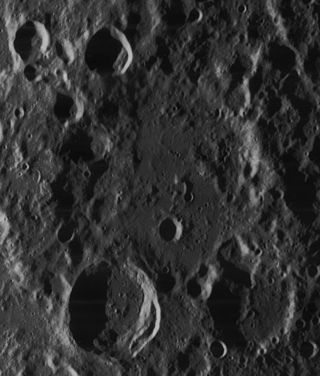
Riemann is a lunar impact crater that is located near the northeastern limb of the Moon, and can just be observed edge-on when libration effects bring it into sight. It lies to the east-northeast of the large walled plain Gauss. To the southeast, beyond sight on the far side, is the crater Vestine.
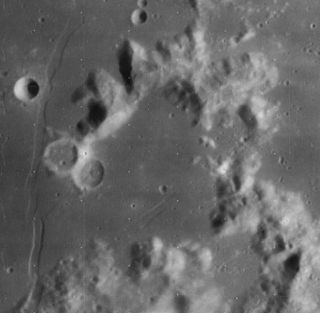
Hall is a lunar impact crater in the southeast part of the Lacus Somniorum, a lunar mare in the northeast part of the Moon. It was named after American astronomer Asaph Hall. This feature can be found to the east of the prominent walled plain Posidonius. Just to the south, and nearly attached to the southern rim of Hall is the smaller crater G. Bond.

d'Alembert is a large lunar impact crater located in the northern hemisphere on the far side of the Moon, to the northeast of the somewhat smaller walled plain Campbell. Astride the southwest rim of d'Alembert is Slipher. To the north is the crater Yamamoto, and to the south-southwest lies Langevin. This walled plain has the same diameter as Clavius on the near side, making it one of the largest such formations on the Moon.
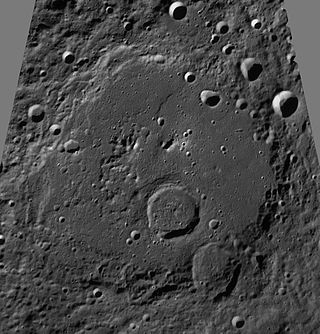
Schwarzschild is a large lunar impact crater, approximately 211 kilometers (131 mi) in diameter. It is located in the northern part of the Moon's far side. The nearest craters of note are Seares to the northeast, and Gamow to the southeast. It was named after German physicist and astronomer Karl Schwarzschild (1873–1916).
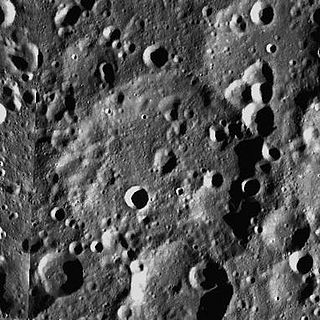
Debye is a lunar impact crater that is located in the northern hemisphere on the Moon's far side, as seen from the Earth. It lies to the south of the crater Chappell, to the southwest of the walled plain Rowland, and to the east of D'Alembert.

Nearch is a lunar impact crater that is located in the southeastern part of the Moon, to the southeast of the crater Hommel. North of Nearch is Vlacq, and to the northeast lies Rosenberger. The crater is 76 kilometers in diameter and 2.9 kilometers deep. It is from the Pre-Nectarian period, 4.55 to 3.92 billion years ago.
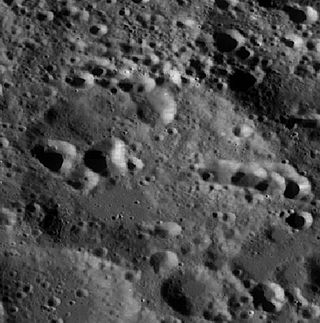
Chandler is a lunar impact crater in the northern hemisphere, on the Moon's far side. It lies to the southeast of the large walled plain D'Alembert, and southeast of the slightly smaller Chernyshev crater.
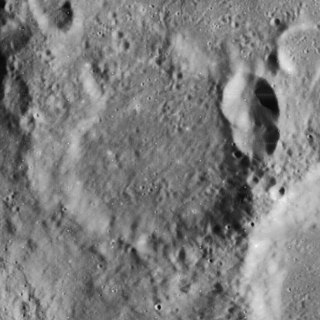
Krusenstern is a lunar impact crater that lies amidst the battered terrain in the southern part of the Moon's near side. Nearly attached to the east-southeast rim is the crater Apianus. Less than one crater diameter to the southwest is the prominent Werner. Krusenstern is intruding into a large circular plain to the north designated Playfair G. Playfair itself lies to the northeast.

Epimenides is a lunar impact crater that is located in the southwestern part of the Moon's near side, just to the east of the oddly shaped crater Hainzel. Just to the north and northeast is Lacus Timoris, a small lunar mare. The crater is 27 kilometers in diameter and 2,000 meters deep. It may be from the Pre-Nectarian period, 4.55 to 3.92 billion years ago.

Lindenau is a lunar impact crater. It is located beside the east-southeastern rim of the crater Zagut, and to the northeast of Rabbi Levi. To the northeast is the slightly smaller crater Rothmann and the Rupes Altai scarp.

Ibn Firnas is a lunar impact crater on the far side of the Moon. Attached to the exterior of its southwestern rim is the prominent crater King. Only a few kilometers to the north, separated by a rugged stretch of terrain, is the larger crater Ostwald.

Evershed is a lunar impact crater on the far side of the Moon, named after the English solar astronomer John Evershed. It is located to the northeast of the larger crater Cockcroft, and to the north of the smaller Van den Bergh.






















